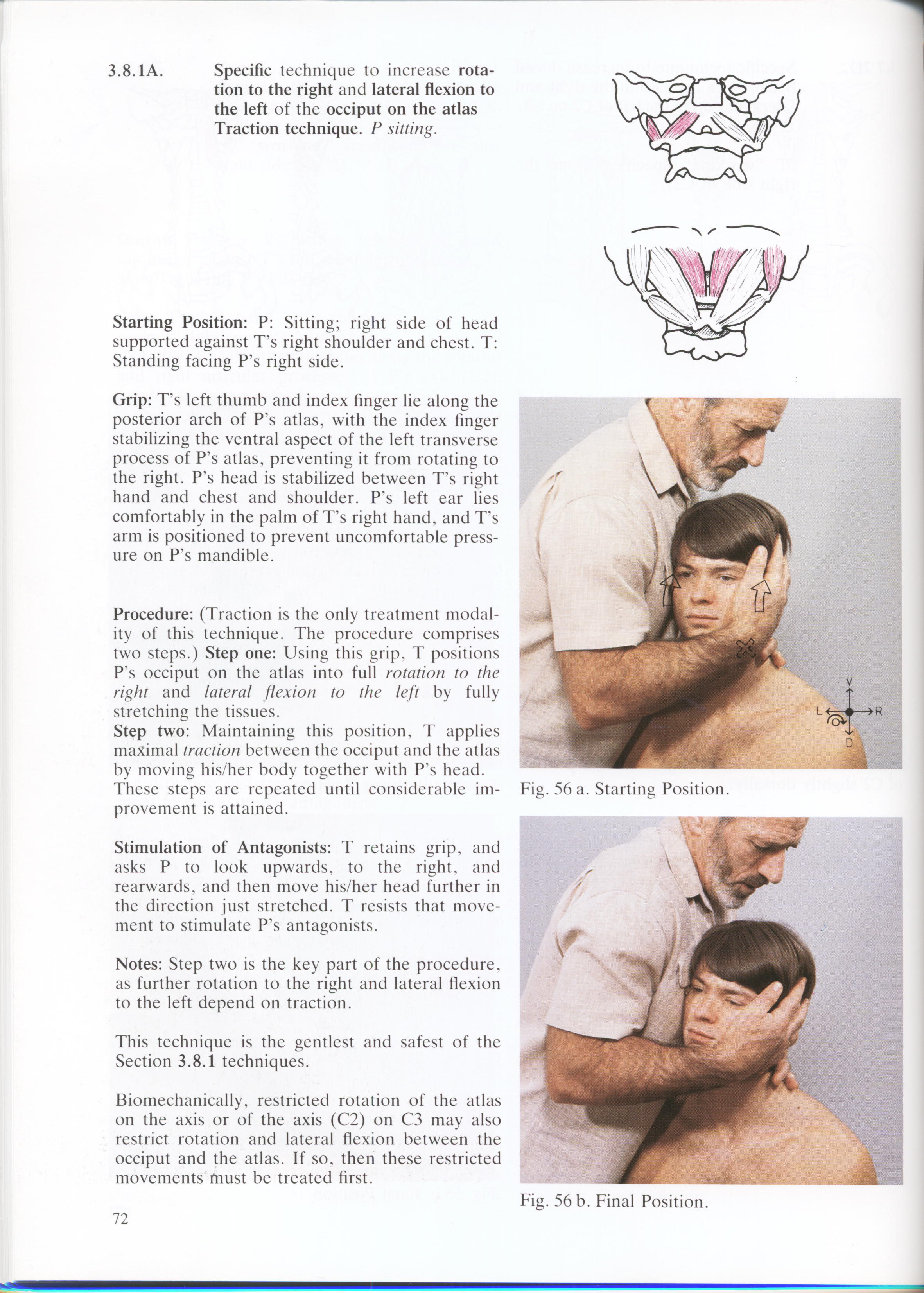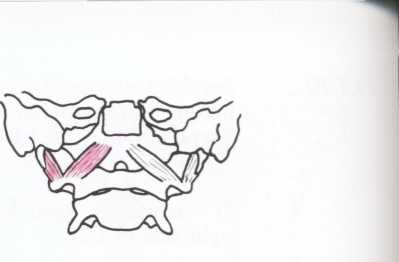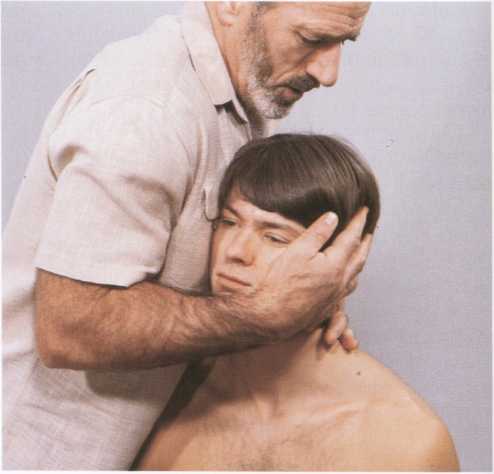72 (211)

3.8.1A.
Specific techniąue to increase rota-tion to the right and lateral flexion to the left of the occiput on the atlas Traction techniąue. P sitting.
Starting Position: P: Sitting; right side of head supported against Ts right shoulder and chest. T: Standing facing P’s right side.
Grip: T’s left thumb and index finger lie along the posterior arch of P’s atlas, with the index finger stabilizing the ventral aspect of the left transverse process of P’s atlas, preventing it from rotating to the right. P’s head is stabilized between T’s right hand and chest and shoulder. P's left ear lies comfortably in the palm of T’s right hand, and T’s arm is positioned to prevent uncomfortable press-ure on P’s mandible.
Procedurę: (Traction is the only treatment modal-ity of this techniąue. The procedurę comprises two steps.) Step one: Using this grip, T positions P’s occiput on the atlas into fuli rotation to the right and lateral flexion to the left by fully stretching the tissues.
Step two: Maintaining this position, T applies maximal traction between the occiput and the atlas by moving his/her body together with P's head. These steps are repeated until considerable im-provement is attained.
Stimulation of Antagonists: T retains grip, and asks P to look upwards, to the right, and rearwards, and then move his/her head further in the direction just stretched. T resists that move-ment to stimulate P’s antagonists.
Notes: Step two is the key part of the procedurę, as further rotation to the right and lateral flexion to the left depend on traction.
This techniąue is the gentlest and safest of the Section 3.8.1 techniąues.
Biomechanically, restricted rotation of the atlas on the axis or of the axis (C2) on C3 may also restrict rotation and lateral tlexion between the occiput and the atlas. If so, then these restricted movements must be treated first.


Fig. 56 a. Starting Position.

Fig. 56 b. Finał Position.
72
Wyszukiwarka
Podobne podstrony:
64 (250) 3.7.1A. Non-specific technique to increase dorsal flexion with rotation to the right a
73 (201) Specific techniąue to increase rota-tion to the right and lateral flexion to the left of th
74 (202) 3.8.1B2. Specific technique to increase rota-tion to the right and lateral flexion to the l
75 (197) 3.8.1C. Specific techniąue to increase rota-tion to the right and lateral flexion to the le
76 (203) 3.9.1A. Specific techniąue to increase rotation to the right of the atlas on the axis Tract
65 (245) 3.7.IB. Non-specific techniąue to increase dorsal flexion with rotation to the right a
66 (237) 3.7.1C. Non-specific techniąue to increase dorsal flexion with rotation to the right a
67 (234) 3.7.2A1. Specific technique to increase dorsal flexion with rotation to the right and
68 (230) 3.7.2A2. Specific techniąue to increase dorsal flexion with rotation to the right and
69 (224) 3.7.2B. Specific techniąue to increase dorsal flexion with rotation to the right and l
71 (223) 3.7.2D. Specific techniąue to increase dorsal flexion with rotation to the right and l
70 (226) 3.7.2C. Specific techniąue to łncrease dorsal flexion with rotation to the right and l
58 (289) 3.6.1A. Non-specific techniąue to increase dorsal flexion with rotation and later-al flexio
77 (197) 3.9.IB. Specific techniąue to increase rota-tion to the right of the atlas on the axis. Tra
38 (492) 3.3.1A. Non-specific technique to increase ventral flexion with rotation and lateral f
60 (278) 3.6.2A. Specific technique to increase dorsal flexion with rotation and lateral flex-ion to
61 (265) 3.6.2B. Specific techniąue to increase dorsal flexion with rotation and lateral flex-ion to
62 (263) 3.6.2C. Specific techniąue to increase dorsal flexion with rotation and lateral flex-ion to
63 (253) 3.6.2D. Specific technique to increase dorsal flexion with rotation and lateral flex-ion to
więcej podobnych podstron